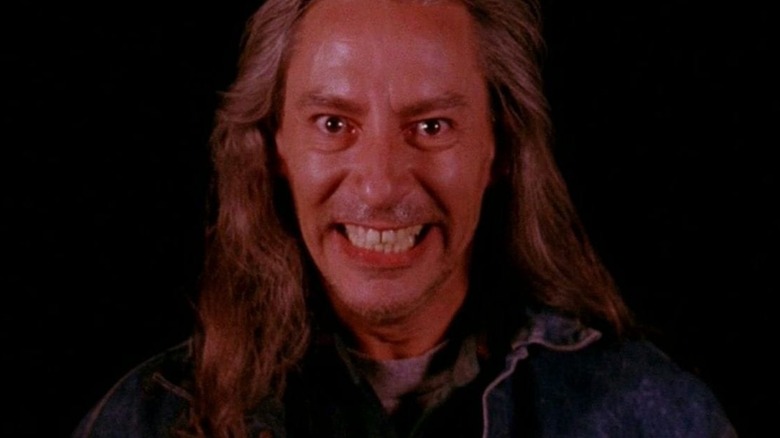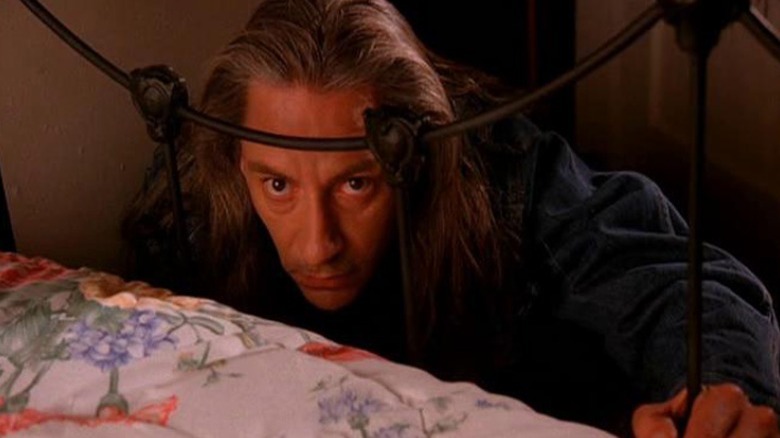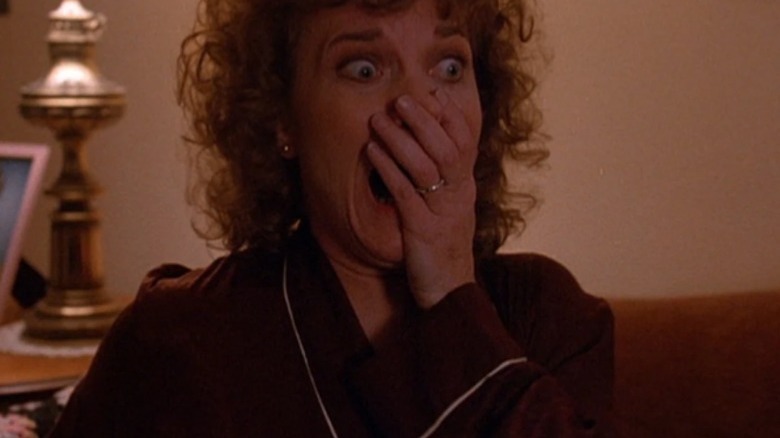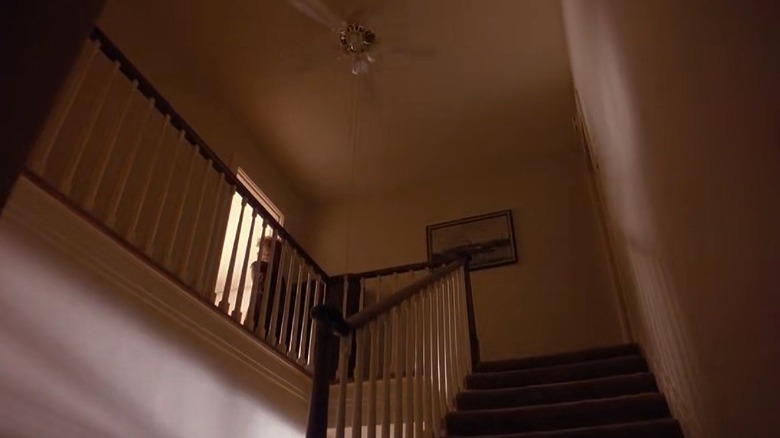The Origin Of Twin Peaks' BOB Is Very David Lynch
1990 was a perfectly fine year for horror: "Jacob's Ladder" twisted our minds, "Childs Play 2" proved Chucky was more than a trend, and "Tremors" and "Arachnophobia" brought horror-comedy back on the scene in a big way. But for my money, nothing on screen in 1990 was scarier than meeting BOB.
The dream-like devil at the center of David Lynch and Mark Frost's "Twin Peaks," BOB (Frank Silva) slunk his way on screen and into our nightmares in the show's pilot episode. Imagery is powerful, and the images Lynch captures of the long-haired man with the rictus grin are seared into viewers' collective imaginations thanks to Lynch's dread-inducing vision of the mysterious villain. The image of BOB climbing over a couch as if lunging towards unassuming viewers is truly terrifying, and it's built from the same type of unnervingly participatory shot that would make "Ringu" a hit years later. Yet before BOB became a fixture in our intrusive thoughts, he was an unassuming set decorator.
Right place, right time
Frank Silva was working as a set dresser on the production of what would become the pilot episode of "Twin Peaks" when, through either a fluke or a stroke of genius, Lynch changed his life. The filmmaker has told the story a few times over the years, including in the featurette "A Slice of Lynch," released with the 2007 "Twin Peaks": Definitive Gold Box Edition. In it, Lynch, producer John Wentworth, and actors Mädchen Amick and Kyle MacLachlan shared stories about their time on the show over cups of coffee.
Here, Lynch frames the BOB epiphany almost like a ghost story, saying he heard a disembodied woman's voice from behind him as he was working on the floor in the Laura Palmer house. Silva, who was getting the room ready for the shoot, had apparently just moved a dresser near the door. The woman — actually an unnamed crew member — joked that Silva shouldn't lock himself in the room, and Lynch was struck with inspiration. "I suddenly pictured Frank in that room," Lynch told the group, noting that the word "locked" piqued his imagination. Here's the rest of the story about BOB's first scene:
"I went running into Frank. I said, 'Frank, are you an actor?' and like everybody in Hollywood, he said, 'Why yes, David, I am.' So I said, 'You're gonna be in this scene,' and he says, 'What am I gonna do?' I said, 'I don't know.' And then we shot these pans, just drifting across the bed. Just a drift across the room, nobody was in it. Then I said, 'Frank, now you get down and hold the end of the bed like this [mimicking grabbing bed frame] and freeze.' We did one shot with him there."
A serendipitous mistake
In a behind-the-scenes featurette for the complete original series Blu-Ray, "Moving Through Time: Fire Walk with Me Memories," Lynch admits he still had no idea how he'd use the footage at this point. The day he shot the bedroom footage turned out to also be the last night the crew planned to shoot in the Palmer house, and before the night was through, Lynch had figured out BOB's purpose. In another memorably jarring sequence, Mrs. Palmer (Grace Zabriskie) smokes a cigarette on the couch when, as Lynch puts it, "Suddenly, she sees something in her mind, bolts upright, and screams."
According to the director, camera operator Sean Doyle got a seemingly perfect shot of the scream, but then approached Lynch with a problem. Unfortunately, a glimpse of a crew member could be caught in the mirror over her head in the shot. "I said, 'Who was reflected in the mirror?'" Lynch recalls in "Moving Through Time." "He said Frank Silva was reflected in the mirror. And that's when I knew that Frank was part of the scene."
There's so much Lynchian genius packed into this anecdote that it's hard to even know where to dig in. First and foremost, the director's spontaneity shows that a more instinctive, free-association artistic practice can be just as powerful as a rigorously plotted one. There's also something impressive about the fact that Lynch knew he wanted Mrs. Palmer to scream thinking about a certain image, but had no idea what image would make her scream until the moment he captured the shot. One of the best shows of all time, then, owes just as much to its visionary filmmaker feeling things out in the moment as it does to its actual script. In the final footage, it's the jump-scare image of BOB at the foot of Laura's bed — the first footage Lynch captured of Silva — that haunts Mrs. Palmer.
The scariest part of Twin Peaks came from spontaneity
The filmmaker was quite literally making things up as he went along, but the results are perfectly eerie and unshakeable. Often when telling the story, Lynch recalls that he was sitting under the ceiling fan when he heard the woman reference Silva locking himself in. He doesn't attempt to explain this creative connection any further, but we see the ceiling fan, ominous and somehow malevolent, in that "Twin Peaks" pilot too. It's no surprise that the ceiling fan somehow relates to BOB, since it gives anyone watching the same gnawing feeling in the pit of their stomach. Somehow, Lynch took a series of random associations and continuity errors, and used them to create one of the most frightening characters ever put to screen.
In his own book, "Catching the Big Fish," Lynch gets a little more introspective about the story of BOB's inception, which he describes as a chance to dream. "Ideas come along in the strangest way when you just pay attention," he advises, "and sometimes things happen on set that make you start dreaming." Lynch ends the anecdote with a simple call to open-minded creation, saying, "One thing leads to another, and if you let it, a whole other thing opens up."
Silva passed away in 1995, but the team behind "Twin Peaks" clearly realized that even with all the directorial creativity in the world, BOB wouldn't have made an impact without the actor's enthusiastic performance. The second episode of "Twin Peaks: The Return" is dedicated to the actor who made BOB come to life.



